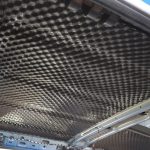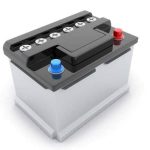The factory battery that comes with a new car cannot provide enough power in some circumstances. Users who like listening to music while the car engine off quickly realize that the factory battery doesn’t last long. Camping enthusiasts know too well that if they have to use the car’s electrical system as a power source, then a secondary battery is a must-have. Also, if you are in the habit of hooking up electronic devices such as laptops and smartphones to the car’s electrical system, you seriously need to install a secondary battery.
How long can my car battery last when the engine is off?
Below is a simple formula for determining the approximate length of time your car battery can last running your stereo with the engine off.
Operating time = 10 X RC/Load
RC stands for battery reserve capacity (in amp-hours) and load is the sustained load power (in watts).
If, for instance, your car audio system has a 500-watt load, and your battery has a reserve capacity of 80 amp-hours, you have 10 X 80/500 = 1.6 hours to enjoy using the car stereo. Note that aftermarket amplifiers and subs have higher loads, meaning less operating time.
Adding a secondary battery increases the reserve capacity and consequently adds operating time.
Determining which battery to add for higher-performance audio
When selecting car batteries for more power for your audio system, you’ll be focused on comparing different models using standard battery power ratings. Battery manufacturers use different ratings to show how much power the battery can provide, and ‘cranking amps’ and ‘reserve capacity are the most important ratings.
‘Cranking amps’ indicates the amount of amperage the battery can output when cranking the engine. ‘Reserve capacity is what the battery can provide over an extended period. The higher the RC, the longer a specific battery will serve your car’s audio system.
The size of the secondary battery is another critical consideration. If you are not dealing with any space limitations, then you can get the biggest battery with the highest reserve capacity. But with space concerns, you’ll have to make a tradeoff between the size of the battery and its reserve capacity.
Installing new matched batteries
A popular way of adding a second battery to your car is replacing the existing one with two matched batteries. For optimal performance, the two replacement batteries must be of the same group, age, and brand as each other. This emphasis on similarity helps to ensure that neither battery is overworked and that one battery doesn’t pull energy from the other when the car engine is off. Unmatched batteries may not last long due to the opposite effects.
The convention is to place one battery right where the old battery was and wiring its counterpart in parallel. The negative terminal on one battery is connected to the negative terminal on the second battery, and the same goes for the positive battery terminals.
Parallel vs. series car battery connection
A parallel connection isn’t the only way of installing a second battery. However, it is the most preferred arrangement. Multiple car batteries can also be connected in series, but there is a difference in the resistance of the batteries.
Connecting car batteries in series may result in the buildup of heat in the first battery. Another disadvantage is that power is not distributed equally between the batteries, so one of the batteries may be overworked.
Placement locations for the second battery vary based on the situation, but most installations happen in the trunk or the passenger compartment. Wherever the secondary battery goes, it’s inherent to use a protective cover on the battery, such as a battery cover.
Installing a second battery to work with the existing battery
If you want to keep your original battery, the wiring is different. You’ll aim at isolating the batteries from each other, and from the rest of the electrical system.
How many times have you found yourself with little to no power to start the car because you accidentally left the headlights on? Too many to count, right?
Here’s the long-awaited solution: a battery isolator
A battery isolator is an essential device during the installation of a second battery. It allows you to charge the auxiliary battery from the car’s alternator. Note that the second battery can be charged by simply connecting the two batteries’ positive terminals. However, this way of connection poses a challenge. When the engine is not running, the starting battery is drained. A battery isolator is designed to solve this challenge. It isolates your batteries to ensure that the alternator only charges your auxiliary battery when your engine is running. Thus, electrical loads will not drain your starting battery, and you’ll have sufficient electricity when most needed.
Isolating the batteries makes sure that you never again find yourself with a flat battery. The original battery is only used when you are driving while the second battery is called upon to work when the car’s parked.
Step-by-step guide for installing a second battery for car improved audio
- Screw the battery tray onto a sturdy surface to reduce the chances of battery movements when the car is in motion.
- Drill holes near the tray to make way for cables. While drilling and screwing, be careful not to hit and damage other components like the fuel tank.
- Now you are about to begin working with wires. Start with disconnecting both the negative and positive cables from the starter battery. Unsnap the negative cable first. Then, there is a wire connecting the alternator to the starter battery. It is part of the battery’s positive cable. Unbolt or cut it off from the alternator end.
- Connect the battery isolator – Connect the disconnected alternator wire to one of the isolator’s side terminals. To the central terminal of the isolator (labeled A), fasten an extra wire and connect it to the alternator. Attach a third longer wire to the remaining terminal of the isolator. This wire will go all the way to the second battery, connecting to the battery’s positive terminal.
- Connect the wire that runs from the starter battery’s negative cable to the negative terminal of the second/auxiliary battery.
- Grounding the second battery – Connect a wire on the second battery’s negative terminal to the chassis or other metal ground.
- Connect your amplifier from the second battery. Attach a red 4-gauge wire to the secondary battery positive end to route it to an amplifier fuse, and then attach another red wire from the fuse to the amplifier.
- As a safety precaution, cover all positive ends connections with a cap to stop any shortages or sparkles that may come from the battery.
- Checking that connections are correct – It’s important to check all connections and verify that they’ve been carried out correctly. A wrong connection may lead to a short or problems starting the car.
Note:
- The system can work with the second battery ungrounded, but grounding both of them and connecting them in parallel helps to avoid many possible issues even before they arise.
- The amp should be connected to the second battery directly and in close proximity. For example, if you choose to install the second battery in the truck, ensure that there’s enough space to install the amplifier in the trunk.
- Use a heavy gauge battery cable for all connections.
Thus far, it’s evident that the benefit of installing a second battery is realized only when the engine is off. When the car engine is active, an extra battery is completely unnecessary as it only adds additional load to the alternator. Remember, the alternator aims to keep all energy storage devices (batteries and capacitors) charged. So, adding another battery means more work for the alternator.
This is a very important note. If you are not intending to listen to music or use the car’s power when the engine is off, then adding a second battery is counterintuitive. In the event that you want to get more power for your audio system while the engine is running, consider adding a capacitor instead of a secondary battery.
Michael Evanchuk is a San Francisco-based sound engineer with 20 years’ experience installing, troubleshooting, and repairing commercial, automotive, and household sound equipment. Evanchuk owns an auto stereo center, where he offers highly competitive car audio installation and repair services. He has written dozens of articles on different sound engineering topics, all of which have been published in leading journals, blogs, and websites.





